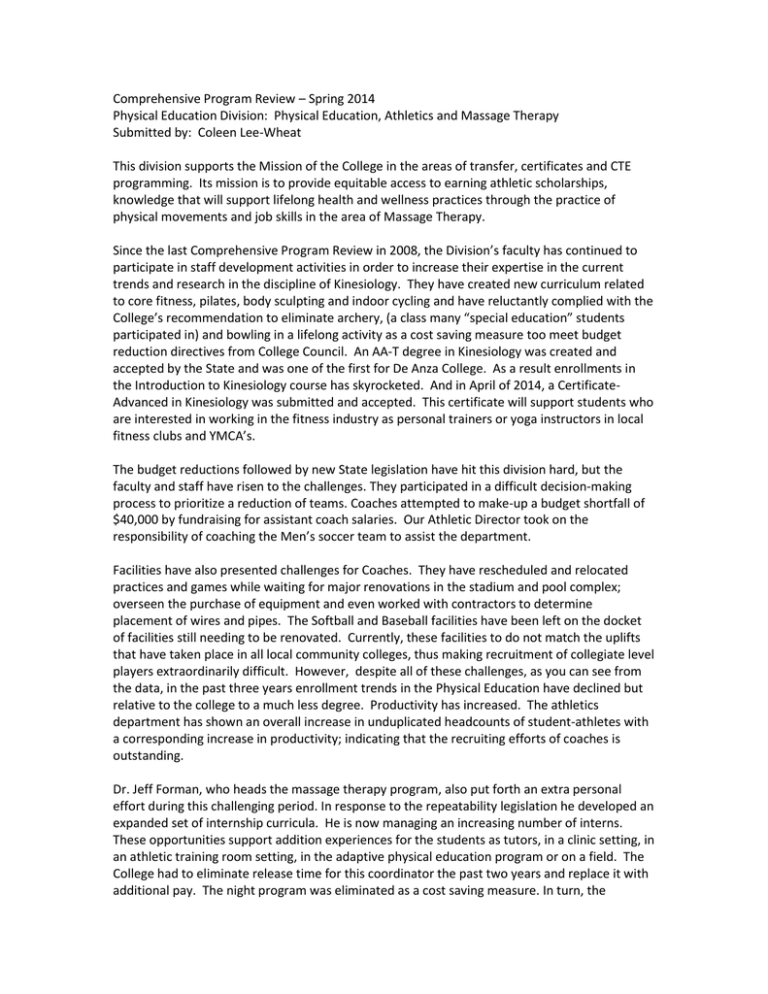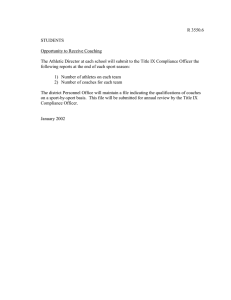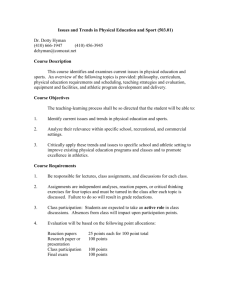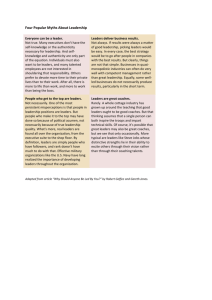Comprehensive Program Review – Spring 2014
advertisement

Comprehensive Program Review – Spring 2014 Physical Education Division: Physical Education, Athletics and Massage Therapy Submitted by: Coleen Lee-Wheat This division supports the Mission of the College in the areas of transfer, certificates and CTE programming. Its mission is to provide equitable access to earning athletic scholarships, knowledge that will support lifelong health and wellness practices through the practice of physical movements and job skills in the area of Massage Therapy. Since the last Comprehensive Program Review in 2008, the Division’s faculty has continued to participate in staff development activities in order to increase their expertise in the current trends and research in the discipline of Kinesiology. They have created new curriculum related to core fitness, pilates, body sculpting and indoor cycling and have reluctantly complied with the College’s recommendation to eliminate archery, (a class many “special education” students participated in) and bowling in a lifelong activity as a cost saving measure too meet budget reduction directives from College Council. An AA-T degree in Kinesiology was created and accepted by the State and was one of the first for De Anza College. As a result enrollments in the Introduction to Kinesiology course has skyrocketed. And in April of 2014, a CertificateAdvanced in Kinesiology was submitted and accepted. This certificate will support students who are interested in working in the fitness industry as personal trainers or yoga instructors in local fitness clubs and YMCA’s. The budget reductions followed by new State legislation have hit this division hard, but the faculty and staff have risen to the challenges. They participated in a difficult decision-making process to prioritize a reduction of teams. Coaches attempted to make-up a budget shortfall of $40,000 by fundraising for assistant coach salaries. Our Athletic Director took on the responsibility of coaching the Men’s soccer team to assist the department. Facilities have also presented challenges for Coaches. They have rescheduled and relocated practices and games while waiting for major renovations in the stadium and pool complex; overseen the purchase of equipment and even worked with contractors to determine placement of wires and pipes. The Softball and Baseball facilities have been left on the docket of facilities still needing to be renovated. Currently, these facilities to do not match the uplifts that have taken place in all local community colleges, thus making recruitment of collegiate level players extraordinarily difficult. However, despite all of these challenges, as you can see from the data, in the past three years enrollment trends in the Physical Education have declined but relative to the college to a much less degree. Productivity has increased. The athletics department has shown an overall increase in unduplicated headcounts of student-athletes with a corresponding increase in productivity; indicating that the recruiting efforts of coaches is outstanding. Dr. Jeff Forman, who heads the massage therapy program, also put forth an extra personal effort during this challenging period. In response to the repeatability legislation he developed an expanded set of internship curricula. He is now managing an increasing number of interns. These opportunities support addition experiences for the students as tutors, in a clinic setting, in an athletic training room setting, in the adaptive physical education program or on a field. The College had to eliminate release time for this coordinator the past two years and replace it with additional pay. The night program was eliminated as a cost saving measure. In turn, the productivity of the program has increased. And to ensure the viability of the program into the future, Dr. Forman who is retiring in June, of 2014 requested a Program Viability review. As a result, the IPBT submitted a recommendation to the College Council to support the Massage Therapy program with permanent funding for a Program Coordinator. There have been a number of new legislative acts that directly affect our programs. Very recently, it has been revealed to the district and department that the Federal Affordable Care Act legislation bear mandated salary and benefits for part-time head coaches and assistant coaches. We are currently grappling with the details of how this might affect the department. Compliance to this law is January of 2015. In October of 2015, the Federal Government is expecting Colleges to implement Title V and Title IX programming surrounding Sexual Harassment and Violence Against Women. “Repeatability Legislation” eliminated repeating of physical education classes and the 350 hour Annual Apportionment Limitations per StudentAthlete Legislation” may reduce productivity in athletics. These laws have stimulated the faculty to create new curriculum, learn how to engage student-athletes in difficult topics such as sexual harassment and violence; “up-stander behavior”; and ponder how to ensure student-success in the classroom. The faculty/coaches are starting to engage in conversations about equity. Every student should be receiving an equitable opportunity to succeed as student-athletes and as students attempting to achieve their fitness goals. As part of this conversation and assessment our faculty have determined a large list of facilities and equipment requests. Fortunately, lottery money can supplement fundraised dollars in providing uniforms and replacement equipment. But meeting facility needs will require sums of money that are beyond what the department or single coaches can earn through fundraising. During 2012-13, as a response to the Board of Trustees, a facilities rental process was developed. This was a positive step towards fundraising for facilities maintenance; a percentage of the fees collected by renting a facility in the Physical Education area will be allocated for this purpose. Upgrading our facilities to provide the use of technology to supplement classroom teaching is also a matter of equity for our student-athletes. In order to be competitive at an intercollegiate level, capturing game and practice performances for subsequent analysis; having the ability to share video with prospective coaches; showcasing events as they happen are all part of the tools necessary provide student-athletes with an equitable chance to earn a scholarship and transfer to a 4 year institution. The SLOAC data at this time shows that our students are meeting our course goals. The statistical data is somewhat skewed in that we have a number of courses (1 unit versions of the same curriculum) that are not currently being taught. Due to the new AAT criteria, we have discovered that only one-unit activity courses will transfer to some institutions. We will be making scheduling adjustments to incorporate more one-unit sections in the future. We have been experimenting with this concept the since the Spring of 2013. PLOAC data at this time shows that a discussion regarding standardizing a set of final exam questions and encouraging staff development in the area of current fitness concepts would be beneficial for our students. The division equity committee feels that a step in this direction may also serve the needs of the targeted populations whose drop/withdraw rates are greater than that of the most successful non-targeted student groups. It is important to note that anecdotal data relative to athletics revealed an equity problem relative to service to female athletes in the training room during the Fall. An assessment tool may be developed to verify this data. It is very plausible however that the numbers of athletes (300 plus during the Fall) are overwhelming for two trainers. The department requested a FT faculty Athletic Trainer position in the fall of 2013. It was denied by the IPBT in light of the unknown impacts of the two new pieces of legislation related to apportionment and repeatability as mentioned before. To conclude, there has been an overwhelming amount of change that has directly impacted the division. For the most part they are marching towards creative solutions. They continue to strive to preserve the integrity of their discipline and programs at De Anza. Increasingly, they are incorporating technology; adding online platforms for lecture classes; participating on campus committees and activities. They are dynamic and consistent in their message: We have a passion for supporting student and student-athlete success in our gymnasiums, pools, on and off- the field because we know that through physical activity there is a guarantee that our students will be healthy citizens who will contribute to their communities. Our division supports the College’s mission to provide viable job opportunities and lifelong learning. The Massage Therapy will serve the community ranging from occupations supporting health and wellness programs to supporting competitive sports. Kinesiologists will have opportunities ranging from Physical Therapists to designing or selling sports footwear and clothing to teaching. More in depth information about each of our departments can be found on each Comprehensive Program Review document.


